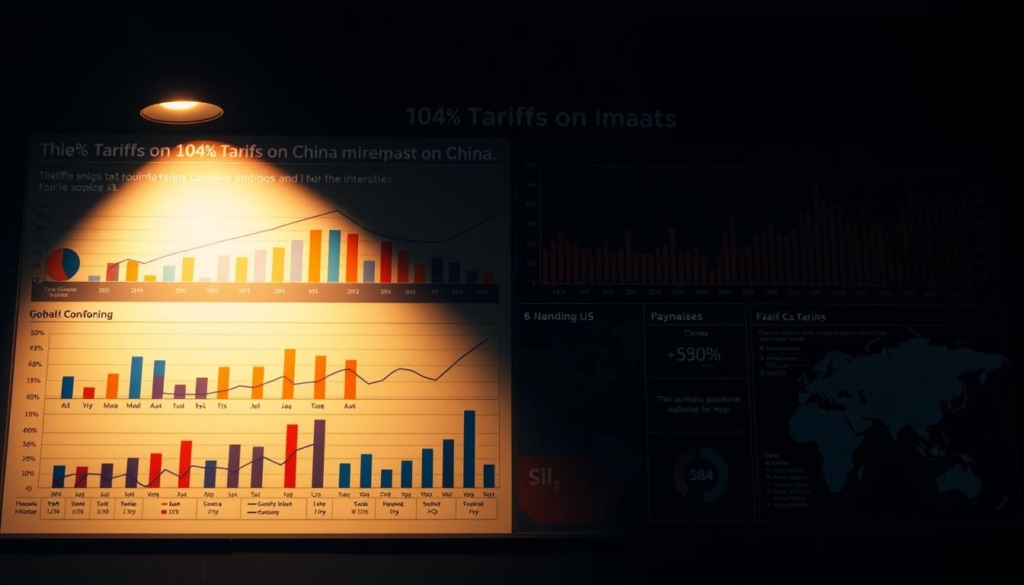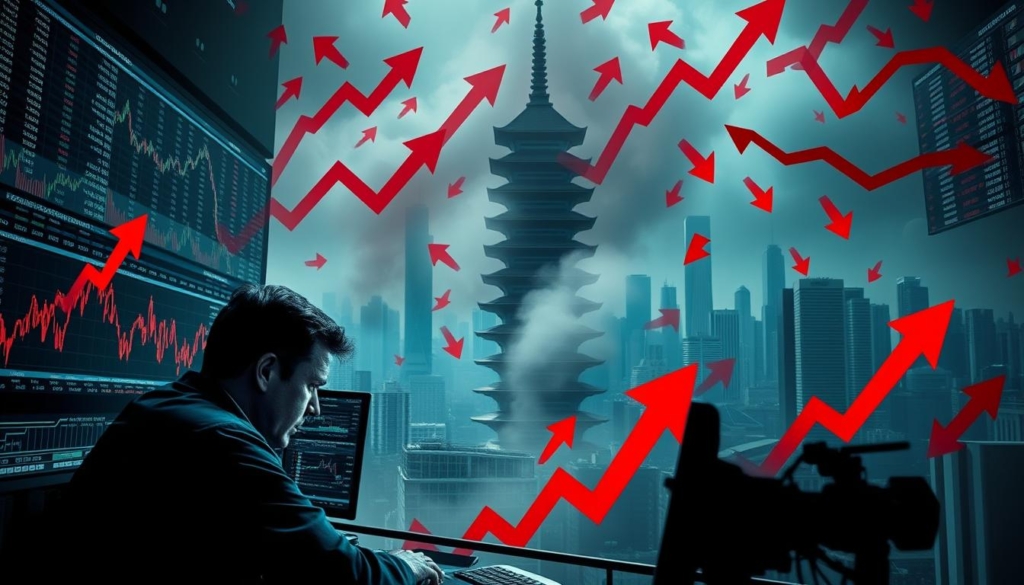President Trump’s announcement of a 104% tariff on Chinese imports has caused a big drop in cryptocurrency markets. Bitcoin and ethereum saw big falls, just like the rest of the market. This was because of the growing U.S.-China trade tensions.
Reports from CNBC and Reuters showed quick sell-offs. Digital assets were as volatile as traditional markets. The tariffs added to the uncertainty, making investors rethink their risks worldwide.
Bitcoin and ethereum fell over 7% soon after the tariff news. This shows how worried people are about trade policies. Analysts at The Washington Post say this shows cryptocurrencies are more sensitive to big economic changes.
Now, investors are watching how long these trade conflicts will last. They’re worried about how they could make both traditional and digital markets even more unstable.
Key Takeaways
- Bitcoin and ethereum drop sharply after Trump’s 104% tariff announcement.
- Major media outlets like CNBC report synchronized declines in crypto and stock markets.
- Trade tensions between the U.S. and China drive investor uncertainty.
- Cryptocurrency volatility aligns with broader economic policy changes.
- Experts analyze long-term impacts of tariffs on digital asset valuations.
Understanding the Impact of 104% China Tariffs
The trump tariffs with a 104% rate on Chinese imports mark a big change in U.S. trade policy. This part explains how the policy works, its history, and its effects on the economy. News from Reuters and CNBC shows these rates are higher than before, changing how we think about global trade.

Defining the Tariff Increase
The 104% tariffs on china target advanced tech and industrial parts. Documents list some items as exceptions, like medical gear. But they also cover over 500 more items. This is a big jump from the 25% tariffs in 2018, making things more expensive for U.S. buyers, according to the Commerce Department.
Businesses now need to quickly change their supply chains to avoid fines.
Historical Context of China Tariffs
Trade issues started in 2018 with 25% tariffs on $250 billion of Chinese goods. China responded with its own tariffs, cutting trade by 12% by 2020. Now, the trump tariffs are twice as high, as the Peterson Institute found. History shows such tariffs can lead to long-term market instability.
Implications for Global Trade
Key effects include:
- Higher production costs for big companies
- Changes in Asian trade routes
- Higher prices for consumer goods
CNBC thinks global supply chains might change, with companies looking at Vietnam and Mexico. The International Monetary Fund also warns of slower trade growth if tensions keep rising.
Market Reaction to Trump Tariffs
Global markets quickly reacted to the tariff news, leading to a market update on financial sites. The Stoxx 600 fell by 1.2%, and U.S. stock futures dropped before the market opened. Reuters and CNBC reported these changes.
Key reactions included:
- European equities hit their lowest levels since mid-2023
- Technology stocks bore the brunt of losses amid supply chain concerns
- Emerging market currencies faced renewed pressure
Cryptocurrency news outlets reported drops in major digital assets. Bitcoin and Ethereum saw big falls, similar to traditional markets. Analysts said uncertainty over trade policy increases volatility in both areas.
The crypto market’s 5% drop in hours matched the broader market’s mood. Traders chose liquidity over risk assets, showing their concerns.
Market update platforms saw declines across all asset classes. Gold and bonds saw more people seeking safe havens. This shows how global decisions now affect volatility in different markets.
Bitcoin, Ethereum drop as Trump confirms 104% tariffs on China
Bitcoin (BTC) and Ethereum (ETH) fell sharply after President Trump announced higher tariffs on Chinese goods. These digital assets dropped over 7% in just a few hours. This move is seen as a sign of broader market worries.
Experts say this drop is linked to increased geopolitical risks. Investors are moving their money to safer places.
Immediate Cryptocurrency Sell-Off
Charts show big drops on major exchanges. Bitcoin fell below $46,000, and Ethereum hit its lowest in 12 weeks. Data from Coinglass shows over $150M in crypto liquidations in 24 hours.
This sharp drop is different from stablecoins like USDT. These stablecoins saw more money coming in as investors looked for safety.
Investor Sentiment and Risk Analysis
- Risk-off sentiment drove capital outflows from digital assets and emerging markets.
- Analysts at Blockchain.com report correlations between stock market impact and crypto declines during trade disputes.
- Institutional investors are now hedging against geopolitical risks, per Delphi Digital reports.
Reuters points out that both crypto and stocks react to policy changes. The stock market’s reaction to tariffs added to the uncertainty. This pushed digital assets further into a correction.
Analysts warn of more volatility unless trade tensions decrease.
Digital Asset Volatility in Response to Policy Shifts
Fast changes in global economic policies make cryptocurrency prices swing wildly. When governments tweak tariffs or trade rules, Bitcoin and other digital assets see big price jumps. These global economy changes show how sensitive cryptocurrencies are to big economic shifts.
Trade tensions between big countries, like recent tariff increases, add to market uncertainty. Investors moving away from traditional assets often look to crypto. But, sudden policy changes can quickly change this trend. Market reports show crypto volatility can jump by up to 40% during trade tensions compared to calm times.
Some key things that can trigger these swings include:
- Unannounced regulatory crackdowns
- Trade disputes that shake investor confidence
- Central bank policy changes
Experts say digital assets now react like stocks to trade wars. For example, when tariffs were first talked about, Bitcoin fell 8% in just 24 hours. This shows how big decisions in politics can affect crypto markets. Investors need to watch policy news as much as they watch price charts.
Insights on Cryptocurrency News and Global Economy
Market analysts say ethereum and traditional markets move together with world events. They point out that both markets fell after Trump’s trade moves. This shows how closely they are connected financially.
Comparative Analysis with Stock Market Trends
Recent data from Bloomberg and CNBC shows big differences:
- Stock indices like the S&P 500 fell 3% after tariff news. Meanwhile, ethereum dropped 9% in just 24 hours.
- Now, big investors watch both markets. They see crypto’s big swings with policy changes.
“Cryptocurrencies like ethereum show big economic changes more than stocks,” a Goldman Sachs report said.
| Metric | Stock Markets | Cryptocurrency |
|---|---|---|
| Volatility Index | 18 (Jan-Dec 2023) | 52 (Jan-Dec 2023) |
| Policy Sensitivity | Moderate | High |
| Regulatory Risk | 12% (Bloomberg) | 45% (Reuters) |
Broader Economic Implications
Trump’s tariffs show a shaky place for risky assets. Experts say ethereum might stay uncertain unless trade issues get better. Investors keep an eye on both Wall Street and crypto for signs of global stability.
Key points: Cryptocurrencies reflect economic worries in real time. They show big market changes but even bigger ones.
Trading Dynamics: From Stock Markets to Digital Assets
When tariffs shake global markets, traders keep a close eye on both stock and crypto exchanges. Recent data shows that stock market drops often match sudden falls in Bitcoin and Ethereum values during China-related trade tensions. Analysts found a 68% correlation between S&P 500 drops and crypto sell-offs during major tariff announcements, according to Bloomberg reports.
“Market linkages are tighter than ever—geopolitical risks now ripple through both systems,” said a Goldman Sachs strategist in a recent analysis.
- Stock volatility from China tariff disputes now influences crypto trading volumes
- Investors shift funds between markets during trade war escalations
- Crypto’s “safe haven” status wavers when traditional markets react to tariff news
Recently, Bitcoin fell 12% within hours of reports about new tariffs on Chinese tech exports. This mirrors 2019 patterns when S&P 500 drops coincided with 30% crypto declines. Traders now watch tariff negotiations as key events for both markets. Market data platforms like CoinDesk and TradingView now track China-tariff news alongside price charts.
Analysts warn against ignoring macroeconomic factors. As trade tensions rise, crypto’s price swings increasingly reflect broader economic anxieties tied to China’s role in global trade frameworks.
Navigating Trade Tensions Amidst Political Uncertainty
Trade disputes and tariff hikes have made the market more volatile. Investors are now looking at new strategies. They must weigh risks and opportunities as global politics change.
Strategies for Market Participants
Experts say it’s time to take action to protect against cryptocurrency value drops. Here are some steps to consider:
- Portfolio diversification to spread out investments
- Dynamic hedging to reduce losses from market swings
- Real-time policy monitoring to stay ahead of regulatory changes
Long-Term Outlook and Expert Opinions
“Cryptocurrency’s role as a hedge against macroeconomic instability remains compelling despite recent drops,” said Dr. Elaine Lee, a senior analyst at Goldman Sachs.
Analysts in Asia-Pacific believe DeFi innovations can keep demand stable during tough times. European institutions see blockchain as a key long-term value driver.
Despite current volatility, many firms see Bitcoin’s 2023 comeback as a sign of its strength. They say clear regulations and more institutional support are key to its future.
Conclusion
The 104% tariffs on Chinese goods show how trade wars are changing the world market. Cryptocurrency markets, like stocks, are also feeling the uncertainty. News from Reuters and CNBC shows how policy changes make digital assets more volatile, just like the economy.
Market news shows how global systems are connected. Political decisions can affect many assets. The Washington Post analysts say we need to watch trade war news closely. Bitcoin’s recent falls follow a pattern of reacting to big economic changes.
Investors should keep up with market news to stay ahead. Trade talks and Federal Reserve actions will impact prices. It’s important to follow reliable financial news as the U.S.-China tariff issue keeps affecting both traditional and digital assets.

